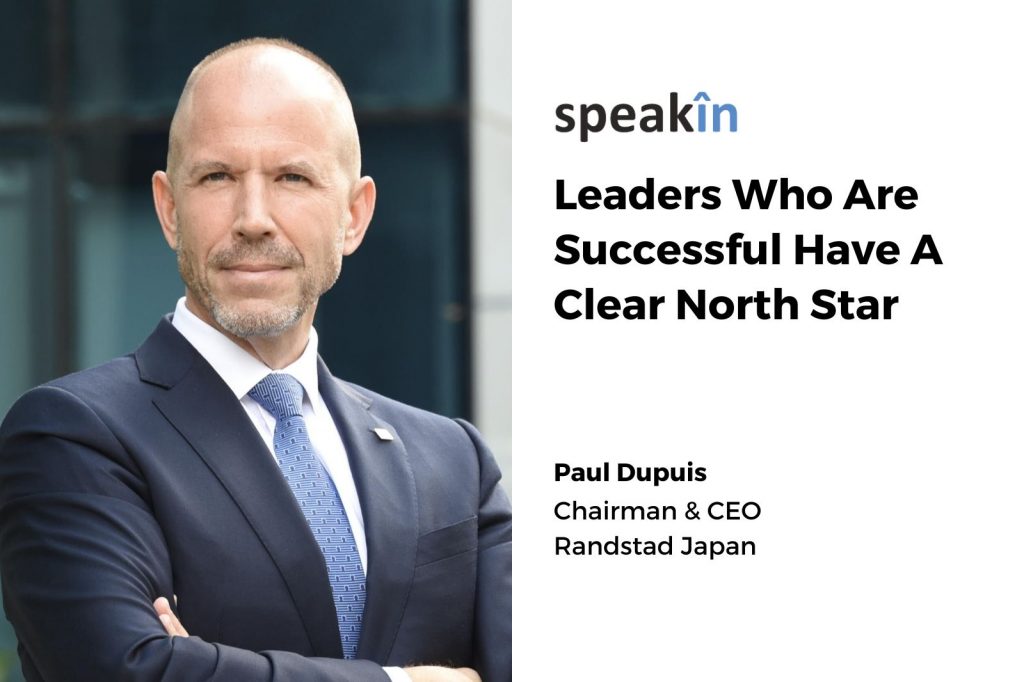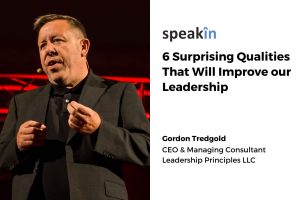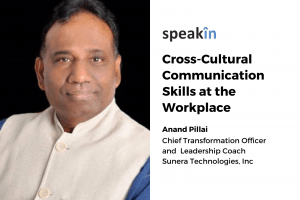Leaders Who Are Successful Have A Clear North Star

Paul Dupuis is the Chairman and Chief Executive Officer of Randstad Japan, the global leader in the HR services industry. From a young backpacker, sleeping on a park bench in Japan, to leading one of the biggest corporate giants in the Asia-Pacific region, Paul Dupuis has built a career through game changing leadership – crafted through his own real-life experiences as an athlete, volunteer and CEO. His E5 framework is a unique leadership model – a call to action to all leaders, globally, to inspire and lead for change.
Leader, speaker, author and volunteer, here’s Paul in his own words, talking about his life, learnings and philosophy.
Beginnings and fascination for Asia
I am from Windsor, Ontario, in Canada. It’s the automotive capital of Canada, an industrial and manufacturing hub. The town has a strong sense of community. So, I grew up in a family where we were three boys and played a lot of sports, especially ice-hockey.
I always had a fascination with Asia growing up. l was quite into the martial arts. My first taste of leadership came through sports. When you play team sport you have to be a follower and, sometimes, you get an opportunity to be the captain as well. I had the opportunity to do both and from there I learned a bit about leadership.
My fascination with Asia began in 1990, when I left Canada with a backpack and a dream for Osaka, Japan. I had about 300 Canadian dollars in my pocket, my life’s savings. I didn’t have anywhere to stay, didn’t understand a word of Japanese, and I didn’t have a job. I had a working holiday visa which would allow me to get a job and stay for six months.
The first night in Osaka I slept on a park bench in downtown Osaka, with my red backpack as my pillow. I was supposed to stay there for six months but I fell in love with Japan and I ended up living there for five years. In fact, I have been in and out of Japan for about 25 years in all, so Japan has been a big part of me.
I got deep into karate, training six days a week, and that’s when I learned Japanese and also about Japanese culture. I also learned about the Asian approach to leadership. In Canada much earlier, I had been a high school teacher for ten years. So, everything you do in your life becomes a tool in your toolbox. As a teacher I learnt so many lessons—I learnt about pedagogy, about how people absorb and process content and information, how to spark motivation and much else.
Back in Japan, I was an entrepreneur I did a number of things and, at one point, in 2011, as the Asia-Pacific head of a large Japanese job portal. In 2013, I joined Randstad. I was there to lead the growth of Randstad, Japan. I was enjoying my work there since I understand the culture and language. It was my comfort zone.
My India affair
Then in 2016 I moved out of my comfort zone and shifted to India and became MD and CEO of Randstad India.
India had been a country which I had danced around but never actually had a chance to dive into. India is a very expressive culture. Which I love. I grew up in an Italian-Canadian home, which is quite similar to India. It’s a fascinating country and I thoroughly enjoyed being here. What I like about India is there is an eagerness which I haven’t seen anywhere. There’s this spirit of embracing new ideas and a focus on the future.
In Japan ‘Kaizen’ is about identifying bottlenecks and the wastage and about being meticulous. It’s a lot of hard work and it takes time. On the other hand, in India when you say ‘go’ as a leader, the team goes and they go fast. The challenge in India is to make sure that they stay on task and they stay focused.
India has a secret weapon which may be controversial, but I like it a lot—it’s Jugaad. If you harness Jugaad for its creativity, ingenuity and entrepreneurial spirit, and marry it with ‘Kaizen’…those two together create magic.
India is still the fastest growing economy in the world although we are in challenging times. It’s the youngest population workforce in the world. So you have got a young workforce that is eager, ambitious and has the ‘let’s try it’ spirit.
My E5 book
The book is representative of my journey. I think we all have a book in our head somewhere but to get it down on paper in a way that is compelling and readable, is the challenge.
The book is not just about leadership, it’s more than that. It’s actually a collection of stories from my journey as a leader—starting from the ice-hockey playground in Canada. It’s a model of leadership which I have built over the years simply by observing exceptional leaders over the years but also about leaders who are not so effective. You learn from both. In the book I talk a lot about leadership in a variety of arenas—sports, politics, business, religion and so on. I started to identify the common denominators of effective and better leadership, and those common denominators formed my own ‘ism’ of leadership, my own version of leadership. I have been sharing these learning with my team and the people I have worked with.
I was in London Business School in 2018, and we were talking about transformative leadership. I was talking with a professor, he asked me about my idea of effective leadership. Then, he says, I went on for about 20 minutes with this very well crafted idea of leadership. The professor responded by saying: Paul, you should write a book.
This was the first time anyone had said that to me. Then, coincidentally, and serendipitously, two or three more people also said the thing out of the blue. I saw this as a bit of sign and decided to write the book.
The 5 Es
Envision
Great leaders whom I have observed and studied, and those I’ve had the pleasure to work with, were very good at crafting a vision which touched the hearts and the minds. A lot of us leaders are in a trap of focusing mainly on ‘what’ and ‘how’. What we discovered is that exceptional leaders speak a lot more about the ‘why’ and less about the what and the how. The trouble is that the vision becomes too grand and is not digestible. A vision has to be razor-sharp and compelling.
Express
Sharing in the current world is just not about getting on the stage; it’s also about expressing your vision. We need to address all kinds of learners since there are different kinds of learners. You need to leverage every form of touchpoint and contact, including social media. There are seven types of learners and you need to engage with them differently and ensure that they buy into the vision. It’s not an easy task but there’s no way around it. Good leaders must do that.
Excite
You can have a well crafted vision and have a omni-channel strategy but if people don’t get excited then the vision never comes to life. It is not necessarily about charisma, not being about loud and flashy, it’s more about pushing the right buttons so that people are inspired to take actions. And the proof comes when teams are keen and eager to stand up, to get off their seats and go and they start using language like—when can we start? Let’s do this. They start raising their hands and say I want to lead this.
Enable
Enabling is about ensuring that your teams have the tools they need to bring the vision to life. It’s about creating a platform or arena where people can shine. Shining sometimes means experimenting. It means the freedom to fall down, but equally the freedom to get back up and try again.
Execute
Execution is about bringing the vision to reality for measurable impact. In a business environment we can simply measure by output. When you have the right people, the right support, the right culture, the right strategy and leadership, then the outcome is inevitable.
Doing well and doing good
When you are in a team it’s all about you. Even in my 20s, it was all about the best I could be. So I was competing in karate six days a week, I fought Japan nationals, I wanted that gold medal. I kept pushing myself. It was all about me, me, me… Then I got married and I had kids and I started to realise—now there are new words: ‘we’ and ‘us’. When I became a leader for the first time, I was no longer an individual contributor; I had people who depended on me. From doing well for myself, it was now about doing well together.
Then in my 40s I started to think about greater purpose of life and realised that doing well is not good enough. A truly rich life is about doing well and doing good. So excelling at what you do, yes, but at the same time doing something that’s good for the world as a whole. All of us have our own ways of doing good, it could be in our behaviour, in our thoughts, in our actions. Some of us are attracted to certain causes whether it’s about protecting the planet, protecting the unprotected… so many options.
For me ‘doing well and doing good’ became my guiding principle, my North Star. I have got a few examples as well, one is from Cambodia in 1992, when Pol Pot was still in power, Khmer Rouge, absolute horrible times, genocides, one-third of the population was absolutely wiped out by Khmer Rouge. I went there and fell in love with the country. Fast forward 15 years later I got involved with an NGO called Hope International, which is a sustainable development agency, which uses Muhammad Yunus’s Grameen Bank model for microcredit.
Instead of using money we used cow banks. So we lent cows to the very poor in Cambodia and we taught them how to plough fields. They were typically single mothers. Then we would help them grow the crops to feed the kids and over time they made excess, we would take them to market and show them how to sell the excess crops and that would be the first time in their lives they would touch money, then they would enter the economy.
Leadership in times of Covid
Leaders show their true stuff in times of crisis, not when they are good. Leaders who have stepped up have shown conviction and grabbed the wheel. When the ship is in choppy waters that’s the time for the leader to grab the wheel and steer the ship. Also, it is time to be honest with the people—yeah, we are in the middle of a storm, we don’t know when it is going to end, but end it will one day. Leaders who are successful have a clear north star and are able to reassure the team that we are safe.
We can think of leadership almost in terms of building muscles. The one thing that is crucial is compassion. It starts with empathy, which is about understanding how the other person is feeling, but compassion is doing something about it. We never start meetings with numbers and spreadsheets. Numbers are the outcome of having the right people in the right seats with right support. Many of the old school leaders have suffered through this crisis. In this new world it is about having your finger on the pulse and knowing how people are feeling and how you can help them accelerate and shine and grow.
If you look at organisations through the pandemic that are thriving, rather than just surviving, are the ones that are putting people first. Wellness has taken on a deeper meaning. Not just physical health, but also mental health, emotional well-being. They would have realised in March 2020 that things have changed so drastically and we are in for a marathon. Those organisations are now future proof, ready for what lies ahead.





